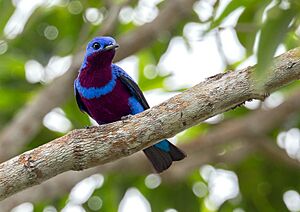Banded cotinga facts for kids
Quick facts for kids Banded cotinga |
|
|---|---|
 |
|
| Conservation status | |
| Scientific classification | |
| Genus: |
Cotinga
|
| Species: |
maculata
|
 |
|
The banded cotinga (Cotinga maculata) is a beautiful bird. It belongs to a family called Cotingidae. This bird lives only in southeastern Brazil. It makes its home in warm, wet lowland forests. Sadly, the banded cotinga is in danger. There are only about 250 to 999 adult birds left. This is mainly because their habitat (where they live) is disappearing.
Contents
What Does the Banded Cotinga Look Like?
Banded cotingas are about 20 centimeters (8 inches) long. That's about the length of a standard pencil.
Male vs. Female Birds
Male banded cotingas are very colorful. They have bright blue feathers with black spots on their backs. Their throats and bellies are a vibrant purple. They also have a clear blue band across their chest.
Female banded cotingas look quite different. They are a dull brown color. They have some white spots or streaks, which is called mottling.
Special Feathers
The male birds have special feathers on their wings. These are called primary feathers. When the male flies or displays for a mate, these feathers make a soft whirring sound.
Where Do Banded Cotingas Live?
Most banded cotingas live in the state of Bahia in Brazil. Sometimes, they are seen in the nearby state of Minas Gerais.
Past Homes
Scientists believe these birds once lived in Rio de Janeiro and Espírito Santo. But they are no longer found there. This means they have been "extirpated" from those areas.
How Do Banded Cotingas Live?
Banded cotingas spend their lives high up in the trees. They live in the canopy of the lowland Atlantic forest.
What Do They Eat?
These birds have a varied diet. They eat seeds and different kinds of berries. They especially like berries from the Byrsonima sericea plant. They also enjoy fruits from fig trees. Besides plants, they eat caterpillars and other insects.
Bird Neighbors
The banded cotinga shares its home with other unique birds. These include the saffron toucanet and the pin-tailed manakin.
Nesting Habits
Banded cotingas do not migrate. This means they stay in the same area all year round. Their nest is quite simple. It is shaped like a small cup.
Why Are Banded Cotingas in Danger?
The biggest threat to the banded cotinga is deforestation. This is when forests are cut down. When their homes disappear, these birds have nowhere to live.
Habitat Loss
The forests where they live are also becoming broken up. This is called habitat fragmentation. It makes it harder for the birds to find food and mates. This is causing their numbers to drop quickly.
Helping the Banded Cotinga
Luckily, some areas are protected. Places like the RPPN Estação Veracel and Reserva Serra Bonita are safe havens for these birds. These protected areas help the banded cotinga survive.


